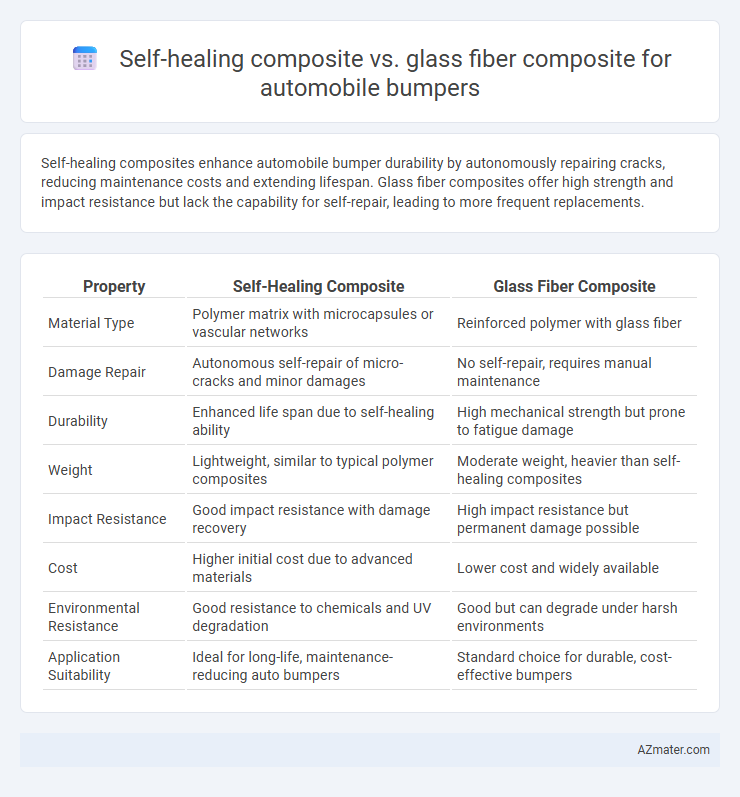Self-healing composites enhance automobile bumper durability by autonomously repairing cracks, reducing maintenance costs and extending lifespan. Glass fiber composites offer high strength and impact resistance but lack the capability for self-repair, leading to more frequent replacements.
Table of Comparison
| Property | Self-Healing Composite | Glass Fiber Composite |
|---|---|---|
| Material Type | Polymer matrix with microcapsules or vascular networks | Reinforced polymer with glass fiber |
| Damage Repair | Autonomous self-repair of micro-cracks and minor damages | No self-repair, requires manual maintenance |
| Durability | Enhanced life span due to self-healing ability | High mechanical strength but prone to fatigue damage |
| Weight | Lightweight, similar to typical polymer composites | Moderate weight, heavier than self-healing composites |
| Impact Resistance | Good impact resistance with damage recovery | High impact resistance but permanent damage possible |
| Cost | Higher initial cost due to advanced materials | Lower cost and widely available |
| Environmental Resistance | Good resistance to chemicals and UV degradation | Good but can degrade under harsh environments |
| Application Suitability | Ideal for long-life, maintenance-reducing auto bumpers | Standard choice for durable, cost-effective bumpers |
Introduction to Automobile Bumper Materials
Automobile bumpers require materials that combine impact resistance, durability, and lightweight properties to enhance vehicle safety and efficiency. Self-healing composites introduce advanced polymer matrices with embedded microcapsules that autonomously repair minor damages, reducing maintenance costs and extending bumper lifespan. Glass fiber composites, traditionally used for their high tensile strength and cost-effectiveness, provide reliable structural support but lack intrinsic damage repair capabilities.
Overview of Self-Healing Composites
Self-healing composites for automobile bumpers incorporate microcapsules or vascular networks that release healing agents upon damage, enabling automatic repair of cracks and improving durability compared to traditional materials. These composites enhance impact resistance and extend the lifespan of bumpers, reducing maintenance costs and environmental waste. Unlike glass fiber composites, which rely on mechanical reinforcement, self-healing composites actively restore structural integrity, offering superior performance in automotive safety applications.
Glass Fiber Composites: Properties and Uses
Glass fiber composites exhibit high tensile strength, lightweight nature, and excellent impact resistance, making them ideal for automobile bumper applications where durability and crash absorption are critical. These composites offer superior corrosion resistance and thermal stability compared to conventional materials, enhancing the longevity and safety of vehicle components. Their cost-effectiveness and ease of manufacturing support widespread adoption in automotive industries for energy-absorbing bumper systems.
Mechanical Strength Comparison
Self-healing composites for automobile bumpers exhibit enhanced mechanical strength by autonomously repairing microcracks, leading to prolonged durability and resistance to impact compared to traditional glass fiber composites. Glass fiber composites typically offer high tensile strength and stiffness but lack the damage recovery capability, resulting in compromised structural integrity after repeated impacts. The self-healing mechanism in these composites improves fatigue resistance and extends service life, making them superior in maintaining mechanical performance under dynamic loading conditions.
Impact Resistance: Self-Healing vs. Glass Fiber
Self-healing composites significantly enhance impact resistance in automobile bumpers by autonomously repairing micro-cracks and damages, thereby maintaining structural integrity over time. In contrast, glass fiber composites exhibit high initial impact strength but lack the ability to recover from damage, leading to potential failure under repeated stress. The integration of self-healing polymers within fiber-reinforced matrices offers superior durability and extended service life compared to traditional glass fiber materials.
Durability and Longevity Analysis
Self-healing composites for automobile bumpers exhibit enhanced durability by autonomously repairing micro-cracks, significantly extending the bumper's functional lifespan compared to traditional glass fiber composites. Glass fiber composites, while strong and lightweight, lack intrinsic repair mechanisms, making them prone to damage accumulation and reduced longevity under repeated stress. The integration of self-healing polymers within composites offers superior resistance to fatigue and environmental degradation, resulting in longer-lasting, more reliable bumper performance.
Weight and Fuel Efficiency Considerations
Self-healing composites in automobile bumpers offer significant weight reduction compared to traditional glass fiber composites, enhancing overall fuel efficiency by lowering vehicle mass. The advanced polymer matrix in self-healing composites provides optimal strength-to-weight ratios, reducing the energy required for propulsion. This weight advantage directly contributes to decreased fuel consumption and emissions, aligning with automotive industry goals for sustainability and performance.
Cost and Economic Feasibility
Self-healing composites for automobile bumpers offer long-term economic benefits by reducing maintenance and replacement costs despite higher initial material expenses compared to traditional glass fiber composites. Glass fiber composites provide a cost-effective solution with established manufacturing processes and lower upfront costs but incur higher lifecycle costs due to damage susceptibility and repair requirements. Evaluating total cost of ownership, self-healing composites demonstrate greater economic feasibility for high-performance or premium vehicles where durability and reduced downtime justify the investment.
Environmental Impact and Sustainability
Self-healing composites in automobile bumpers significantly reduce environmental impact by extending product lifespan and minimizing waste generation compared to glass fiber composites, which often contribute to landfill accumulation due to limited recyclability. The sustainable advantage of self-healing composites lies in their ability to autonomously repair micro-cracks, lowering the need for frequent replacements and resource consumption. Glass fiber composites, while offering strength and durability, pose challenges in recycling and often involve energy-intensive production processes with higher carbon footprints.
Future Trends in Automotive Composites
Self-healing composites for automobile bumpers exhibit promising advancements in durability and damage repair by autonomously restoring structural integrity, reducing maintenance costs and extending vehicle lifespan. Compared to traditional glass fiber composites, self-healing materials integrate microcapsules or vascular networks that trigger repair processes upon impact, enhancing safety and sustainability in automotive design. Future trends emphasize the integration of smart materials and nanotechnology to optimize performance, weight reduction, and environmental impact, positioning self-healing composites as a transformative innovation in automotive composites.

Infographic: Self-healing composite vs Glass fiber composite for Automobile bumper
 azmater.com
azmater.com